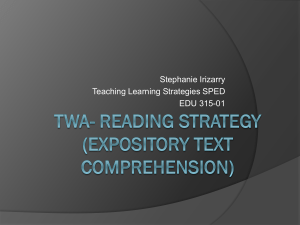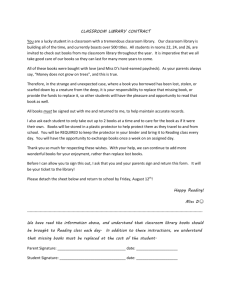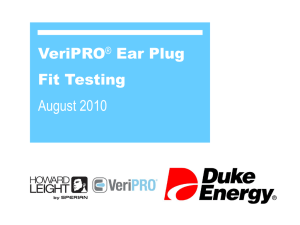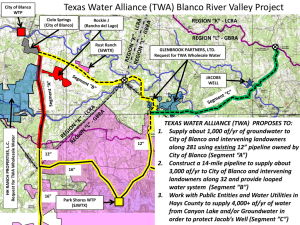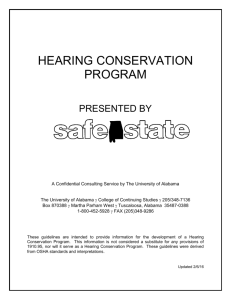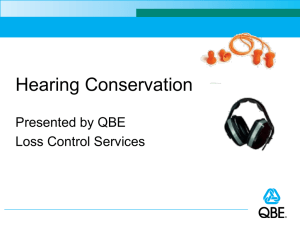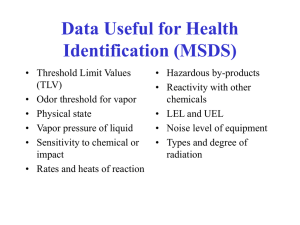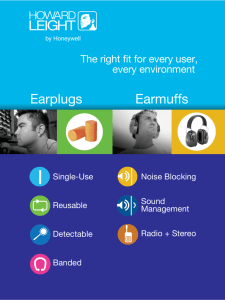Methods for Estimating HPD Attenuation
advertisement
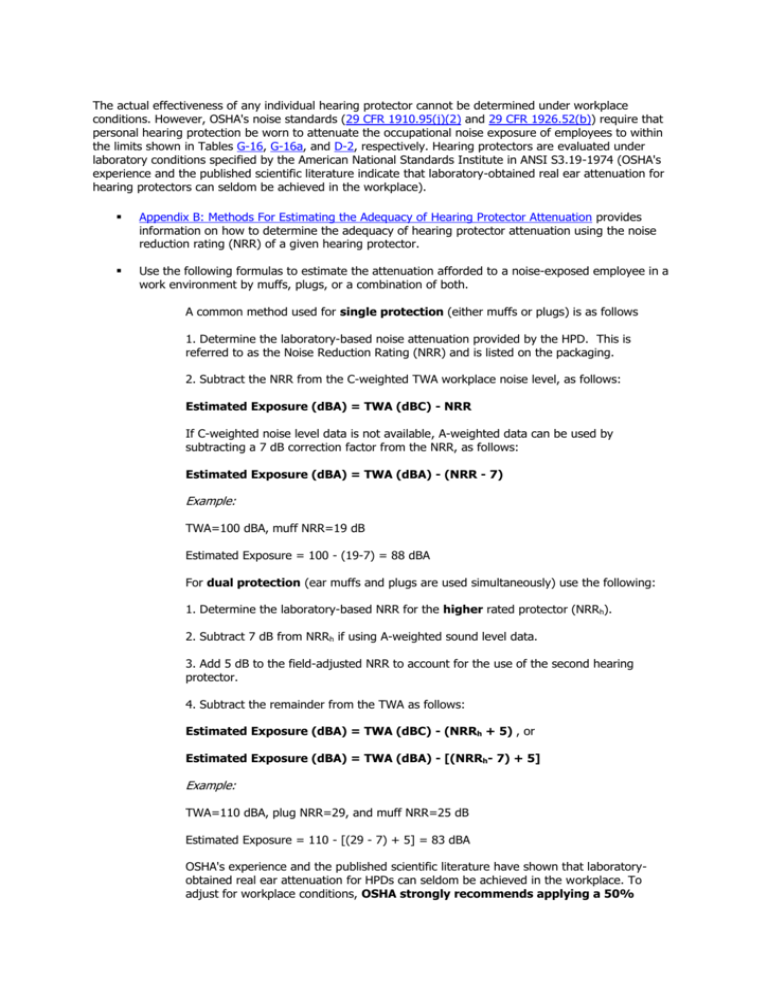
Appendix IV:C. Methods for Estimating HPD Attenuation
The actual effectiveness of any individual hearing protector cannot be determined under workplace
conditions. However, OSHA's noise standards (29 CFR 1910.95(j)(2) and 29 CFR 1926.52(b)) require that
personal hearing protection be worn to attenuate the occupational noise exposure of employees to within
the limits shown in Tables G-16, G-16a, and D-2, respectively. Hearing protectors are evaluated under
laboratory conditions specified by the American National Standards Institute in ANSI S3.19-1974 (OSHA's
experience and the published scientific literature indicate that laboratory-obtained real ear attenuation for
hearing protectors can seldom be achieved in the workplace).
Appendix B: Methods For Estimating the Adequacy of Hearing Protector Attenuation provides
information on how to determine the adequacy of hearing protector attenuation using the noise
reduction rating (NRR) of a given hearing protector.
Use the following formulas to estimate the attenuation afforded to a noise-exposed employee in a
work environment by muffs, plugs, or a combination of both.
A common method used for single protection (either muffs or plugs) is as follows
1. Determine the laboratory-based noise attenuation provided by the HPD. This is
referred to as the Noise Reduction Rating (NRR) and is listed on the packaging.
2. Subtract the NRR from the C-weighted TWA workplace noise level, as follows:
Estimated Exposure (dBA) = TWA (dBC) - NRR
If C-weighted noise level data is not available, A-weighted data can be used by
subtracting a 7 dB correction factor from the NRR, as follows:
Estimated Exposure (dBA) = TWA (dBA) - (NRR - 7)
Example:
TWA=100 dBA, muff NRR=19 dB
Estimated Exposure = 100 - (19-7) = 88 dBA
For dual protection (ear muffs and plugs are used simultaneously) use the following:
1. Determine the laboratory-based NRR for the higher rated protector (NRRh).
2. Subtract 7 dB from NRRh if using A-weighted sound level data.
3. Add 5 dB to the field-adjusted NRR to account for the use of the second hearing
protector.
4. Subtract the remainder from the TWA as follows:
Estimated Exposure (dBA) = TWA (dBC) - (NRRh + 5) , or
Estimated Exposure (dBA) = TWA (dBA) - [(NRRh- 7) + 5]
Example:
TWA=110 dBA, plug NRR=29, and muff NRR=25 dB
Estimated Exposure = 110 - [(29 - 7) + 5] = 83 dBA
OSHA's experience and the published scientific literature have shown that laboratoryobtained real ear attenuation for HPDs can seldom be achieved in the workplace. To
adjust for workplace conditions, OSHA strongly recommends applying a 50%
correction factor when estimating field attenuation. This is especially important when
considering whether engineering controls are to be implemented. The equations above
would then be modified as follows:
Single Protection:
Estimated Exposure (dBA) = TWA (dBC) - [NRR x 50%], or
Estimated Exposure (dBA) = TWA (dBA) - [(NRR - 7) x 50%]
Dual Protection:
Estimated Exposure (dBA) = TWA (dBC) - [(NRRh x 50%) + 5] , or
Estimated Exposure (dBA) = TWA (dBA) - {[(NRRh - 7) x 50%] + 5}
Methods for estimating the adequacy of hearing protector attenuation
This Appendix is Mandatory
For employees who have experienced a significant threshold shift, hearing protector attenuation must
be sufficient to reduce employee exposure to a TWA of 85 dB. Employers must select one of the
following methods by which to estimate the adequacy of hearing protector attenuation.
The most convenient method is the Noise Reduction Rating (NRR) developed by the Environmental
Protection Agency (EPA). According to EPA regulation, the NRR must be shown on the hearing
protector package. The NRR is then related to an individual worker's noise environment in order to
assess the adequacy of the attenuation of a given hearing protector. This appendix describes four
methods of using the NRR to determine whether a particular hearing protector provides adequate
protection within a given exposure environment. Selection among the four procedures is dependent
upon the employer's noise measuring instruments.
Instead of using the NRR, employers may evaluate the adequacy of hearing protector attenuation by
using one of the three methods developed by the National Institute for Occupational Safety and
Health (NIOSH), which are described in the "List of Personal Hearing Protectors and Attenuation
Data," HEW Publication No. 76-120, 1975, pages 21-37. These methods are known as NIOSH
methods No. 1, No. 2 and No. 3. The NRR described below is a simplification of NIOSH method No. 2.
The most complex method is NIOSH method No. 1, which is probably the most accurate method
since it uses the largest amount of spectral information from the individual employee's noise
environment. As in the case of the NRR method described below, if one of the NIOSH methods is
used, the selected method must be applied to an individual's noise environment to assess the
adequacy of the attenuation. Employers should be careful to take a sufficient number of
measurements in order to achieve a representative sample for each time segment.
NOTE: The employer must remember that calculated attenuation values reflect realistic values only to
the extent that the protectors are properly fitted and worn.
When using the NRR to assess hearing protector adequacy, one of the following methods must be
used:
(i) When using a dosimeter that is capable of C-weighted measurements:
(A) Obtain the employee's C-weighted dose for the entire workshift, and convert to TWA (see
appendix A, II).
(B) Subtract the NRR from the C-weighted TWA to obtain the estimated A-weighted TWA under the
ear protector.
(ii) When using a dosimeter that is not capable of C-weighted measurements, the following method
may be used:
(A) Convert the A-weighted dose to TWA (see appendix A).
(B) Subtract 7 dB from the NRR.
(C) Subtract the remainder from the A-weighted TWA to obtain the estimated A-weighted TWA under
the ear protector.
(iii) When using a sound level meter set to the A-weighting network:
(A) Obtain the employee's A-weighted TWA.
(B) Subtract 7 dB from the NRR, and subtract the remainder from the A-weighted TWA to obtain the
estimated A-weighted TWA under the ear protector.
(iv) When using a sound level meter set on the C-weighting network:
(A) Obtain a representative sample of the C-weighted sound levels in the employee's environment.
(B) Subtract the NRR from the C-weighted average sound level to obtain the estimated A-weighted
TWA under the ear protector.
(v) When using area monitoring procedures and a sound level meter set to the A-weighing network.
(A) Obtain a representative sound level for the area in question.
(B) Subtract 7 dB from the NRR and subtract the remainder from the A-weighted sound level for that
area.
(vi) When using area monitoring procedures and a sound level meter set to the C-weighting network:
(A) Obtain a representative sound level for the area in question.
(B) Subtract the NRR from the C-weighted sound level for that area.

